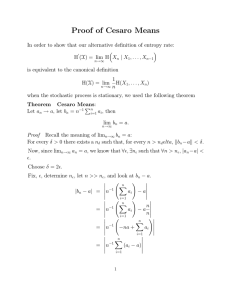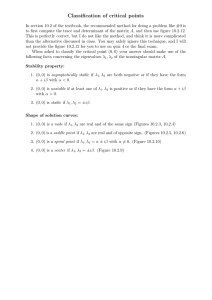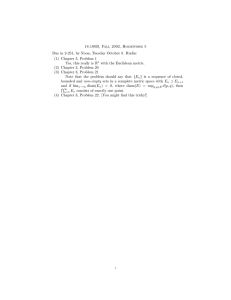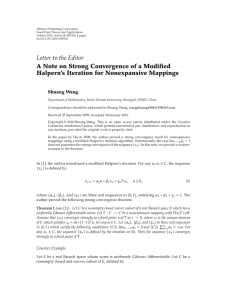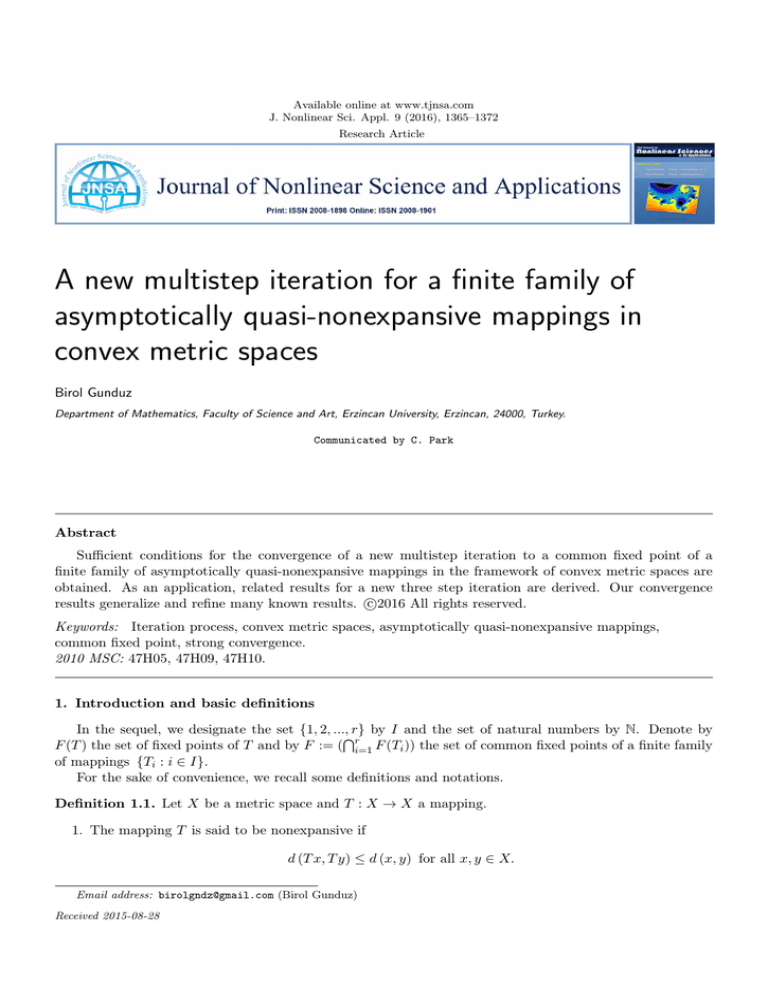
Available online at www.tjnsa.com
J. Nonlinear Sci. Appl. 9 (2016), 1365–1372
Research Article
A new multistep iteration for a finite family of
asymptotically quasi-nonexpansive mappings in
convex metric spaces
Birol Gunduz
Department of Mathematics, Faculty of Science and Art, Erzincan University, Erzincan, 24000, Turkey.
Communicated by C. Park
Abstract
Sufficient conditions for the convergence of a new multistep iteration to a common fixed point of a
finite family of asymptotically quasi-nonexpansive mappings in the framework of convex metric spaces are
obtained. As an application, related results for a new three step iteration are derived. Our convergence
c
results generalize and refine many known results. 2016
All rights reserved.
Keywords: Iteration process, convex metric spaces, asymptotically quasi-nonexpansive mappings,
common fixed point, strong convergence.
2010 MSC: 47H05, 47H09, 47H10.
1. Introduction and basic definitions
In the sequel, we designate the set {1, 2, ...,Tr} by I and the set of natural numbers by N. Denote by
F (T ) the set of fixed points of T and by F := ( ri=1 F (Ti )) the set of common fixed points of a finite family
of mappings {Ti : i ∈ I}.
For the sake of convenience, we recall some definitions and notations.
Definition 1.1. Let X be a metric space and T : X → X a mapping.
1. The mapping T is said to be nonexpansive if
d (T x, T y) ≤ d (x, y) for all x, y ∈ X.
Email address: birolgndz@gmail.com (Birol Gunduz)
Received 2015-08-28
B. Gunduz, J. Nonlinear Sci. Appl. 9 (2016), 1365–1372
1366
2. The mapping T is said to be quasi-nonexpansive if F (T ) 6= ∅ and
d (T x, p) ≤ d (x, p) for all x ∈ X and p ∈ F (T ).
3. The mapping T is said to be asymptotically nonexpansive [2] if there exists a un ∈ [1, ∞) for all n ∈ N
with limn→∞ un = 1 such that
d (T n x, T n y) ≤ un d (x, y) for ∀x, y ∈ X and n ∈ N.
4. The mapping T is said to be asymptotically quasi-nonexpansive if F (T ) 6= ∅ and there exists a
un ∈ [1, ∞) for all n ∈ N with limn→∞ un = 1 such that
d (T n x, p) ≤ un d (x, p) ∀x ∈ X, ∀p ∈ F (T ) and n ∈ N.
Remark 1.2. From the above definition, it follows that if F (T ) is nonempty, then a nonexpansive mapping
is quasi-nonexpansive, and an asymptotically nonexpansive mapping is asymptotically quasi-nonexpansive.
However, the converses of these statements are not true, in general (see, for example, [2, 6, 14, 21]).
In 1970, Takahashi [18] introduced the concept of convexity in metric spaces and studied the properties
of such spaces.
Definition 1.3 ([18]). A convex structure in a metric space (X, d) is a mapping W : X × X × [0, 1] → X
satisfying for all x, y, u ∈ X and all λ ∈ [0, 1],
d (W (x, y, λ) , u) ≤ λd (x, u) + (1 − λ) d (y, u) .
A metric space together with a convex structure is called a convex metric space.
A nonempty subset C of X is said to be convex if W (x, y, λ) ∈ C for all (x, y, λ) ∈ C × C × [0, 1]. The
following holds in convex metric spaces [18] for all x, y ∈ X and λ ∈ [0, 1],
d(W (x, y, λ), x) = (1 − λ)d(x, y) and d(W (x, y, λ), y) = λd(x, y).
Every normed space (and Banach space) is a special convex metric space with a convex structure W (x, y, λ) =
λx + (1 − λ) y for all x, y ∈ X and λ ∈ [0, 1]. In fact,
d (W (x, y, λ) , u) = k(λx + (1 − λ) y) − uk
≤ λ kx − uk + (1 − λ) ky − uk
= λd (x, u) + (1 − λ) d (y, u)
∀u ∈ X.
But there are many examples of convex metric spaces which cannot be embedded in any normed space [3].
In 2008, Khan et al. [9] introduced the following iterative process for a finite family of mappings. Let
{Ti : i ∈ I} be a family of self-mappings of C, where C is a convex subset of a Banach space X. Suppose
that αin ∈ [0, 1] for all n = 1, 2, . . . and i = 1, 2, . . . , r. For x1 ∈ C, let the sequence {xn } be defined by the
following algorithm:
xn+1 = (1 − αrn ) xn + αrn Trn y(r−1)n ,
n
y(r−1)n = 1 − α(r−1)n xn + α(r−1)n Tr−1
y(r−2)n ,
n
y(r−2)n = 1 − α(r−2)n xn + α(r−2)n Tr−2
y(r−3)n ,
..
.
y2n = (1 − α2n ) xn + α2n T2n y1n ,
y1n = (1 − α1n ) xn + α1n T1n y0n ,
(1.1)
B. Gunduz, J. Nonlinear Sci. Appl. 9 (2016), 1365–1372
1367
where y0n = xn for all n. The iterative process (1.1) is a generalized form of the modified Mann (one-step)
iterative process of Schu [15], the modified Ishikawa (two-step) iterative process of Tan and Xu [20], and the
three-step iterative process of Xu and Noor [22].
In [7], Khan and Ahmed transformed process (1.1) for convex metric spaces as follows.
Let C be a convex subset of a convex metric space X and {Ti : i = 1, 2, . . . , r} a finite family of selfmappings of C. Suppose that αin ∈ [0, 1] for all n = 1, 2, . . . and i = 1, 2, . . . , r. Given x0 ∈ X, let the
sequence {xn } be defined by the iteration process
xn+1 = W Trn y(r−1)n , xn , αrn ,
n
y(r−1)n = W Tr−1
y(r−2)n , xn , α(r−1)n ,
n
y(r−2)n = W Tr−2
y(r−3)n , xn , α(r−2)n ,
(1.2)
..
.
y2n = W (T2n y1n , xn , α2n ) ,
y1n = W (T1n y0n , xn , α1n ) ,
where y0n = xn for all n.
Inspired and motivated by these definitions, we introduce a new more general multistep iteration process
for a finite family of asymptotically quasi-nonexpansive mappings in convex metric spaces as follows.
Let (X, d) be a convex metric space with convex structure W and Ti : X → X (i ∈ I) a finite family of
asymptotically quasi-nonexpansive mappings. Then for a given x1 ∈ X and n ≥ 1, compute iteratively the
sequences {xn }, {yn },. . . ,{yn+r−2 } by
yn = W (Trn xn , xn , αnr ) ,
βn(r−1)
n
n
yn+1 = W Tr−1 xn , W Tr−1 yn , xn ,
, αn(r−1) ,
1 − αn(r−1)
βn(r−2)
n
n
, αn(r−2) ,
yn+2 = W Tr−2 yn , W Tr−2 yn+1 , xn ,
1 − αn(r−2)
..
.
βn2
n
n
, αn2 ,
yn+r−2 = W T2 yn+r−4 , W T2 yn+r−3 , xn ,
1 − αn2
βn1
xn+1 = W T1n yn+r−3 , W T1n yn+r−2 , xn ,
, αn1 ,
1 − αn1
(1.3)
where {αni } , {βni } are appropriate real sequences in [0, 1] such that αni + βni < 1 for all i ∈ I. The iteration
(1.3) is called the modified multistep iteration for a finite family of asymptotically quasi-nonexpansive
mappings in convex metric spaces. For r = 3, (1.3) reduces to the modified three-step iteration:
yn = W (T3n xn , xn , αn3 ) ,
βn2
n
n
yn+1 = W T2 xn , W T2 yn , xn ,
, αn2 ,
1 − αn2
βn1
n
n
, αn1 ,
xn+1 = W T1 yn , W T1 yn+1 , xn ,
1 − αn1
(1.4)
where {αni } , {βni } are sequences in [0, 1] such that αni + βni < 1 for each i ∈ {1, 2, 3} and n ≥ 1. The
modified multistep iteration (1.3) coincides with the iterative scheme of Yang [23] in Banach space setting,
when W (x, y, α) = αx + (1 − α) y. The iteration scheme (1.4) coincides with the modified Noor iterative
scheme defined by Suantai [17] in Banach space, when W (x, y, α) = αx + (1 − α) y and Ti = T for all
i ∈ {1, 2, 3}. Using “W (x, y, 0) = y for any x, y ∈ X ([19], Proposition 1.2(a))”, the modified multistep
B. Gunduz, J. Nonlinear Sci. Appl. 9 (2016), 1365–1372
1368
iteration (1.3) reduces in convex metric spaces to Khan and Ahmed [7] iteration (1.4) with αn1 = αn2 =
· · · = αn(r−1) = 0. By the same argument, iterations (1.3) and (1.4) reduce in Banach spaces to Xu–Noor
algorithm [22], Ishikawa algorithm, Mann algorithm, and their convex metric spaces versions.
The purpose of this paper is to discuss strong convergence theorems of the modified multistep iteration
(1.3) for a finite family of asymptotically quasi-nonexpansive mappings in convex metric spaces. And to give
strong convergence of the modified three-step iteration (1.4) for three asymptotically quasi-nonexpansive
mappings in convex metric spaces. The main result is an extension and improvement of corresponding
results in [3, 4, 5, 7, 9, 10, 11, 12, 13, 14, 16, 17, 23, 24].
In order to prove our main result, we need the following useful lemma and proposition.
Lemma 1.4 ([12]). Let {an } and {bn } be two nonnegative sequences satisfying
∞
X
bn < ∞, an+1 = (1 + bn ) an , n ≥ 0.
n=0
Then
i) limn→∞ an exists,
ii) if either lim inf n→∞ an = 0 or lim supn→∞ an = 0, then limn→∞ an = 0.
Proposition 1.5 ([9]). Let X be a convex
Trmetric space and Ti : X → X a finite family of asymptotically
quasi-nonexpansive mappings with F := ( i=1 F (Ti )) 6= ∅. Then, there exist a point p ∈ F and a sequence
{un } ⊂ [1, ∞) with limn→∞ un = 1 such that
d (Tin x, p) ≤ un d (x, p)
for all x ∈ X, for each i ∈ I.
2. Strong Convergence Theorems of Modified Multistep Iteration
The following lemma is crucial for proving the main theorems.
Lemma 2.1. Let (X, d) be a convex metric space and TiP
: X → X (i ∈ I) a finite family of asymptotically
quasi-nonexpansive mappings with F 6= ∅. Suppose that ∞
n=1 (un − 1) < ∞ and that {xn } is obtained by
modified multistep iteration (1.3). If limn→∞ d (xn , F ) = 0 where d (x, F ) = inf {d (x, p) : p ∈ F }, then {xn }
is a Cauchy sequence.
Proof. For all p ∈ F , we have from Proposition 1.5 and (1.3) that
d (yn , p) = d (W (Trn xn , xn , αnr ) , p)
≤ αnr d (Trn xn , p) + (1 − αnr ) d (xn , p)
≤ αnr un d (xn , p) + (1 − αnr ) d (xn , p)
≤ un d (xn , p) .
Using a similar method, together with (2.1), we get
n
n
d (yn+1 , p) = d W Tr−1 xn , W Tr−1
yn , xn ,
βn(r−1)
, αn(r−1) , p
1 − αn(r−1)
βn(r−1)
n
n
≤ αn(r−1) d Tr−1 xn , p + (1 − αn(r−1) )d W Tr−1 yn , xn ,
,p
1 − αn(r−1)
≤ αn(r−1) un d (xn , p)
βn(r−1)
βn(r−1)
n
+(1 − αn(r−1) )
d(Tr−1 yn , p) + 1 −
d (xn , p)
1 − αn(r−1)
1 − αn(r−1)
≤ αn(r−1) un d (xn , p) + βn(r−1) un d (yn , p) + (1 − αn(r−1) − βn(r−1) )d (xn , p)
≤ αn(r−1) un d (xn , p) + βn(r−1) u2n d (xn , p) + (1 − αn(r−1) − βn(r−1) )d (xn , p)
≤ u2n d (xn , p) .
(2.1)
B. Gunduz, J. Nonlinear Sci. Appl. 9 (2016), 1365–1372
1369
By induction, it follows from (1.3) that we have
d (yn+j , p) ≤ uj+1
n d (xn , p)
for some j = 0, 1, . . . , r − 2. Therefore, it follows from (1.3) and (2.2) that
βn1
d (xn+1 , p) = d W T1n yn+r−3 , W T1n yn+r−2 , xn ,
, αn1 , p
1 − αn1
n
≤ αn1 d (T1 yn+r−3 , p)
βn1
βn1
+ (1 − αn1 )
d (T1n yn+r−2 , p) + 1 −
d (xn , p)
1 − αn1
1 − αn1
≤ αn1 un d (yn+r−3 , p) + βn1 un d (yn+r−2 , p) + (1 − αn1 − βn1 )d (xn , p)
(2.2)
(2.3)
≤ urn d (xn , p)
= (1 + (urn − 1)) d (xn , p) .
Since 0 ≤ tr − 1 ≤ rtr−1 (t − 1) for all t ≥ 1, the assumption
∞
P
(un − 1) < ∞ implies that {un } is bounded;
n=1
then un ∈ [1, M ], ∀n ≥ 1 and for some M . Hence, urn − 1 ≤ rM r−1 (un − 1) holds for all n ≥ 1. Therefore,
∞
P
(urn − 1) < ∞. By Lemma 1.4, we obtain existence of limn→∞ d (xn , p).
n=1
It is well known that 1 + x ≤ ex for all x ≥ 0. Using it and (2.3), we get
d (xn+m , p) ≤ 1 + urn+m−1 − 1 d (xn+m−1 , p)
r
≤ eun+m−1 −1 d (xn+m−1 , p)
r
≤ eun+m−1 −1 1 + urn+m−2 − 1 d (xn+m−2 , p)
r
r
≤ eun+m−1 −1+un+m−2 −1 d (xn+m−2 , p)
..
.
Pn+m−1 r
≤ e j=n (uj −1) d (x , p)
n
≤ M d (xn , p) ,
where M = e
Pn+m−1
j=n
(urj −1) < ∞. That is,
d (xn+m , p) ≤ M d (xn , p)
(2.4)
for all m, n ∈ N and p ∈ F .
Now we use this to prove that {xn } is a Cauchy sequence. From limn→∞ d (xn , F ) = 0 for each ε > 0
there exists an n1 ∈ N such that
ε
d (xn , F ) <
, ∀n ≥ n1 .
M +1
Thus, there exists a q ∈ F such that
ε
d (xn , q) <
, ∀n ≥ n1 .
(2.5)
M +1
Using (2.4) and (2.5), we obtain
d (xn+m , xn ) ≤ d (xn+m , q) + d (xn , q) ≤ M d (xn , q) + d (xn , q)
= (M + 1)d (xn , q)
ε
< (M + 1)
=ε
M +1
for all n, m ≥ n1 . Therefore {xn } is a Cauchy sequence.
B. Gunduz, J. Nonlinear Sci. Appl. 9 (2016), 1365–1372
1370
Now we state and prove our main theorem.
Theorem 2.2. Let (X, d) be a convex metric space and TP
i : X → X (i ∈ I) a finite family of asymptotically
quasi-nonexpansive mappings with F 6= ∅. Suppose that ∞
n=1 (un − 1) < ∞ and that {xn } is obtained by
modified multistep iteration (1.3). Then
(i) If {xn } converges to a unique point in F , then lim inf n→∞ d (xn , F ) = lim supn→∞ d (xn , F ) = 0.
(ii) If X is complete and either lim inf n→∞ d (xn , F ) = 0 or lim supn→∞ d (xn , F ) = 0, then {xn } converges to a unique point in F .
Proof. (i) Let p ∈ F . Since {xn } converges to p, limn→∞ d (xn , p) = 0. So, for a given ε > 0, there exists
an n0 ∈ N such that
d (xn , p) < ε ∀n ≥ n0 .
Taking infimum over p ∈ F , we obtain
d (xn , F ) < ε ∀n ≥ n0 .
This means limn→∞ d (xn , F ) = 0 so that lim inf n→∞ d (xn , F ) = lim supn→∞ d (xn , F ) = 0.
(ii) Suppose that X is complete and lim inf n→∞ d (xn , F ) = 0 or lim supn→∞ d (xn , F ) = 0. Then, we
have from Lemma 1.4(ii) limn→∞ d (xn , F ) = 0. From the completeness of X and Lemma 2.1, we get that
limn→∞ xn exists and equals q ∈ X, say. Moreover, since the set F of fixed points of asymptotically quasinonexpansive mappings is closed, q ∈ F from limn→∞ d (xn , F ) = 0. Hence {xn } converges to a unique point
in F .
Next, we give and prove two corollaries which are consequences of Theorem 2.2.
Corollary 2.3. Let (X, d) be a complete convex metric space and Ti : P
X → X (i ∈ I) a finite family of
asymptotically quasi-nonexpansive mappings with F 6= ∅. Suppose that ∞
n=1 (un − 1) < ∞ and that {xn }
is obtained by modified multistep iteration (1.3). Assume that the following two conditions hold.
i) lim d (xn , xn+1 ) = 0;
(2.6)
n→∞
ii) for the sequence {yn } in X satisfying limn→∞ d (yn , yn+1 ) = 0 we have
lim inf d (yn , F ) = 0 or lim sup d (yn , F ) = 0.
n→∞
(2.7)
n→∞
Then {xn } converges to a unique point in F .
Proof. From (2.6) and (2.7), we have that
lim inf d (xn , F ) = 0 or lim sup d (xn , F ) = 0.
n→∞
n→∞
Therefore, we obtain from Theorem 2.2 (ii) that the sequence {xn } converges to a unique point in F .
Corollary 2.4. Let (X, d) be a complete convex metric space and Ti P
: X → X (i ∈ I) a finite family of
asymptotically quasi-nonexpansive mappings with F 6= ∅. Suppose that ∞
n=1 (un − 1) < ∞ and that {xn } is
obtained by modified multistep iteration (1.3). Assume that limn→∞ d (xn , Ti xn ) = 0. If one of the following
is true, then the sequence {xn } converges to a unique point in F .
i) There exists a nondecreasing function g : [0, ∞) → [0, ∞) with g (0) = 0, g (t) > 0 for all t ∈ (0, ∞)
such that d (xn , Ti xn ) ≥ g (d (xn , F )) for all n ≥ 1 (See Condition A0 of Khan and Fukharuddin [1]).
ii) There exists a function f : [0, ∞) → [0, ∞) which is right continuous at 0, f (0) = 0 and
f (d (xn , Ti xn )) ≥ d (xn , F ) for all n ≥ 1.
B. Gunduz, J. Nonlinear Sci. Appl. 9 (2016), 1365–1372
1371
Proof. First suppose that (i) holds. Then
lim g (d (xn , F )) ≤ lim d (xn , Ti xn ) = 0.
n→∞
n→∞
So, limn→∞ g (d (xn , F )) = 0 and the properties of g imply limn→∞ d (xn , F ) = 0.
Now all the conditions of Theorem 2.2 are satisfied, therefore by its conclusion, {xn } converges to a point
of F .
Next, assume (ii). Then
lim d (xn , F ) ≤ lim f (d (xn , Ti xn )) = f lim d (xn , Ti xn ) = f (0) = 0.
n→∞
n→∞
n→∞
Thus, lim inf n→∞ d (xn , F ) = 0 or lim supn→∞ d (xn , F ) = 0. By Theorem 2.2, {xn } converges to a point of
F.
3. Strong Convergence Theorems of Three-Step Iteration
In this section, we give three convergence theorems related to iteration (1.4). We omit their proofs, since
they are special cases of theorems given in Section 2.
Theorem 3.1. Let (X, d) be a convex metric space and T1 , T2 , T3 : X → X three
P asymptotically quasinonexpansive mappings with a nonempty common fixed point set F . Suppose that ∞
n=1 (un − 1) < ∞ and
that {xn } is obtained by modified three-step iteration (1.4). Then
(i) lim inf n→∞ d (xn , F ) = lim supn→∞ d (xn , F ) = 0 if {xn } converges to a unique point in F .
(ii) {xn } converges to a unique point in F if X is complete and either lim inf n→∞ d (xn , F ) = 0 or
lim supn→∞ d (xn , F ) = 0.
Theorem 3.2. Let (X, d) be a complete convex metric space and T1 , T2 , T3 : X → X three
P asymptotically
quasi-nonexpansive mappings with a nonempty common fixed point set F . Suppose that ∞
n=1 (un − 1) < ∞
and that {xn } is obtained by modified three-step iteration (1.4). Assume that the following two conditions
hold.
i) lim d (xn , xn+1 ) = 0;
n→∞
ii) for the sequence {yn } in X satisfying limn→∞ d (yn , yn+1 ) = 0 we have
lim infn→∞ d (yn , F ) = 0 or lim sup d (yn , F ) = 0.
n→∞
Then {xn } converges to a unique point in F .
Theorem 3.3. Let (X, d) be a complete convex metric space and T1 , T2 , T3 : X → X three asymptotically
quasi-nonexpansive mappings with
P a nonempty common fixed point set F . Assume that limn→∞ d (xn , Ti xn ) =
0 for i = 1, 2, 3. Suppose that ∞
n=1 (un − 1) < ∞ and that {xn } is obtained by modified three-step iteration
(1.4). If one of the following is true, then the sequence {xn } converges to a unique point in F .
i) There exists a nondecreasing function g : [0, ∞) → [0, ∞) with g (0) = 0, g (t) > 0 for all t ∈ (0, ∞)
such that d (xn , Ti xn ) ≥ g (d (xn , F )) for all n ≥ 1.
ii) There exists a function f : [0, ∞) → [0, ∞) which is right continuous at 0, f (0) = 0 and
f (d (xn , Ti xn )) ≥ d (xn , F ) for all n ≥ 1.
Remark 3.4. The results presented in this paper are extensions and improvements of the corresponding
results of Yang [23], Khan and Ahmed [7], Khan et al. [9], Suantai [17], Khan and Hussain [10], Gunduz and
Akbulut [3, 4], Gunduz et al. [5], Nilsrakoo and Saejung [13], Khan and Kim [11], Petryshyn and Williamson
[14], Khan and Yildirim [24], Shahzad and Udomene [16], Khan et al. [8] and Qihou [12].
Remark 3.5. In view of Remark 1.2, our results are valid for asymptotically nonexpansive mappings as well
as nonexpansive mappings and quasi-nonexpansive mappings.
B. Gunduz, J. Nonlinear Sci. Appl. 9 (2016), 1365–1372
1372
Acknowledgement
I would like to thank Prof. Murat Özdemir from Atatürk University for his valuable suggestions during
my work on PhD.
References
[1] H. Fukhar-ud-din, S. H. Khan, Convergence of iterates with errors of asymptotically quasi-nonexpansive mappings
and applications, J. Math. Anal. Appl., 328 (2007), 821–829. 2.4
[2] K. Goebel, W. A. Kirk, A fixed point theorem for asymptotically nonexpansive mappings, Proc. Amer. Math.
Soc., 35 (1972), 171–174. 3, 1.2
[3] B. Gunduz, S. Akbulut, Strong convergence of an explicit iteration process for a finite family of asymptotically
quasi-nonexpansive mappings in convex metric spaces, Miskolc Math. Notes, 14 (2013), 905–913. 1, 1, 3.4
[4] B. Gunduz, S. Akbulut, Strong and ∆-convergence theorems in hyperbolic spaces, Miskolc Math. Notes, 14 (2013),
915–925. 1, 3.4
[5] B. Gunduz, S. H. Khan, S. Akbulut, On convergence of an implicit iterative algorithm for nonself asymptotically
nonexpansive mappings, Hacettepe J. Math. Stat., 43 (2014), 399–411. 1, 3.4
[6] A. Kettapun, A. Kananthai, S. Suantai, A new approximation method for common fixed points of a finite family
of asymptotically quasi-nonexpansive mappings in Banach spaces, Comput. Math. Appl., 60 (2010), 1430–1439.
1.2
[7] A. R. Khan, M. A. Ahmed, Convergence of a general iterative scheme for a finite family of asymptotically quasinonexpansive mappings in convex metric spaces and applications, Comput. Math. Appl., 59 (2010), 2990–2995.
1, 1, 3.4
[8] S. H. Khan, Y. J. Cho, M. Abbas, Convergence to common fixed points by a modified iteration process, J. Appl.
Math. Comput., 35 (2011), 607–616. 3.4
[9] A. R. Khan, A. A. Domlo, H. Fukharuddin, Common fixed point Noor iteration for a finite family of asymptotically
quasi-nonexpansive mappings in Banach spaces, J. Math. Anal. Appl., 341 (2008), 1–11. 1, 1, 1.5, 3.4
[10] S. H. Khan, N. Hussain, Convergence theorems for nonself asymptotically nonexpansive mappings, Comput. Math.
Appl., 55 (2008), 2544–2553. 1, 3.4
[11] S. H. Khan, J. K. Kim, Common fixed points of two nonexpansive mappings by a modified faster iteration scheme,
Bull. Korean Math. Soc., 47 (2010), 973–985. 1, 3.4
[12] Q. Liu, Iterative sequence for asymptotically quasi-nonexpansive mappings with errors member, J. Math. Anal.
Appl., 259 (2001), 18–24. 1, 1.4, 3.4
[13] W. Nilsrakoo, S. Saejung, A new three-step fixed point iteration scheme for asymptotically nonexpansive mappings,
Appl. Math. Comput., 181 (2006), 1026–1034. 1, 3.4
[14] W. V. Pershyn, T. E. Williamson, Strong and weak convergence of the sequence of successive approximations for
quasi-nonexpansive mappings, J. Math. Anal. Appl., 43 (1973), 459–497. 1.2, 1, 3.4
[15] J. Schu, Weak and strong convergence to fixed points of aysmptotically nonexpansive mappings, Bull. Aust. Math.
Soc., 43 (1991), 153–159. 1
[16] N. Shahzad, A. Udomene, Approximating common fixed points of two asymptotically quasi-nonexpansive mappings
in Banach spaces, Fixed Point Theory Appl., 2006 (2006), 10 pages. 1, 3.4
[17] S. Suantai, Weak and strong convergence criteria of Noor iterations for asymptotically nonexpansive mappings,
J. Math. Anal. Appl., 311 (2005), 506–517. 1, 3.4
[18] W. Takahashi, A convexity in metric space and nonexpansive mappings, Kodai. Math. Sem. Rep., 22 (1970),
142–149. 1, 1.3, 1
[19] L. A. Talman, Fixed points for condensing multifunctions in metric spaces with convex structure, Kodai Math.
Sem. Rep., 29 (1977), 62–70. 1
[20] K. K. Tan, H. K. Xu, Fixed point iteration process for asymptotically nonexpansive mappings, Proc. Amer. Math.
Soc., 122 (1994), 733–739. 1
[21] Y. X. Tian, Convergence of an ishikawa type iterative scheme for asymptotically quasi-nonexpansive mappings,
Comput. Math. Appl., 49 (2005), 1905–1912. 1.2
[22] B. Xu, M. A. Noor, Fixed point iterations for asymptotically nonexpansive mappings in Banach spaces, J. Math.
Anal. Appl., 267 (2002), 444–453. 1, 1
[23] L. Yang, Modified multistep iterative process for some common fixed point of a finite family of nonself asymptotically nonexpansive mappings, Math. Comput. Modelling, 45 (2007), 1157–1169. 1, 3.4
[24] I. Yildirim, S. H. Khan, Convergence theorems for common fixed points of asymptotically quasi-nonexpansive
mappings in convex metric spaces, Appl. Math. Comput., 218 (2012), 4860–4866. 1, 3.4


